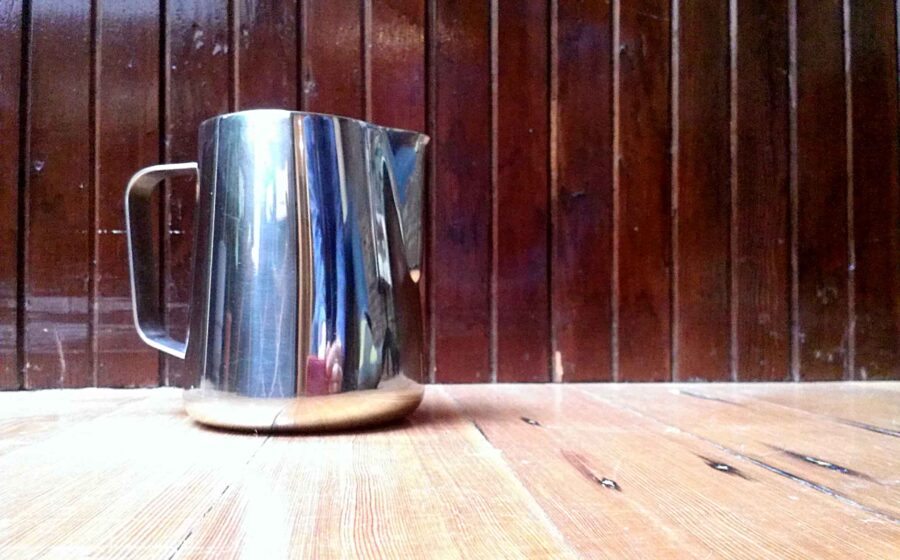[W]hile outfitting a new café, steaming pitchers often end up back-of-mind. Next to sourcing all the machines you’ll need to make a great shot of espresso, the pitcher seems like a gimmie, no need for much thought. That’s mostly true, but if you’re in the middle of opening a café, especially your first, you know that every seemingly easy decision is more complicated than you guessed.
So let’s take some of the complication out of pitchers. I called up reps at several café equipment shops, people who supply and advise a huge range of cafés, to get their take.
What are your options?
There are several shapes for pitchers: bell, graduated, tapered (which slope out and then back in), and straight-sided (which are sometimes called latte art pitchers). There’s no clear, objectively better style. Panda at Espresso Parts (call him Michael Fernandez if you want, but he’ll answer the phone as Panda) says that the best style is the one a person was trained on. Just as you might cook killer eggs on a cheap pan you’ve had since college, it’s all about what you’ve become comfortable with.
But let’s say you’re new to coffee and haven’t been brought into the brotherhood of the bell or the straight-side sorority. Tia Peck at Barista Pro Shop recommends bell pitchers for people new to coffee. This is because when you’re frothing, the bell shape prompts the milk into the vortex you need for great foam and it does it whether or not you’ve positioned the steaming wand properly. It’s easy and forgiving.
Straight-sided pitchers, however, are the most popular in the US. This is largely due to better control of the milk stream, which is why they’re often called latte art pitchers. Steam-wand position does matter, but that’s a skill you should develop.
Along with the different styles, some pitchers have spouts and others don’t. The spouts allow much greater control of where the milk is poured. Some baristas like to slosh the milk from the side of the spoutless pitchers, but that’s a recipe for spilled milk.
How many do you need?
How many of these do you need and what size? That really depends on your shop, so instead of laying down rules, let’s look at a few scenarios that might fit your place.
Akaash Saini from Visions Espresso says that at a high-volume shop he worked at, he had three twenty-ounce and two twelve-ounce pitchers. He was frothing one drink at a time with this setup, and that was with a line out the door for five hours.
If you serve large-sizes (sixteen or twenty ounces) you’ll need large pitchers. If you’re following the decreased size model, then you can use Akaash’s setup. If you run a drive-through or have a crazy-high volume shop, you can steam milk for multiple drinks at once. (I understand this is anathema to many baristas, for good reasons, but it’s common practice.) Tia’s main warning about using large pitchers is the chance for waste is much greater. If you over-pour in a twenty-ounce pitcher you may lose a quarter drink’s worth of milk, but she says, “If you over pour in a thirty-two ounce, you may have a whole drink’s worth of milk that you’ve wasted.”
If you serve multiple types of milk (and you probably do) it’s good to have pitchers for each. Tia says that even a hot-water rinse won’t wash out all the milk in a pitcher, which would be bad news for a customer who is lactose intolerant. Even worse would be the customer who has a nut allergy getting almond-milk leftovers in his latte. Tia says she’s heard of customers flipping over seeing their skim milk go into a pitcher used for whole milk. Obnoxious, for sure, but you know whether or not that could be your customers.
Care and longevity
Most of the pitchers on the market are stainless steel and they will live a long, foamy life if you keep them clean. About the only thing that can break on them is the handle, and Panda says that’s rare.
Rinse the pitcher between every steaming and clean it thoroughly as often as you can. These things are tough, so it can go through the dishwasher and you can go after them with rough scrubbers and grim-busting cleaners.
If you spring for powder-coated pitchers, and they are beautiful, you need to be gentler with them to avoid chipping the sides. Hand-washing these is best for longevity.
Many baristas end up buying their own pitchers to use in competitions, getting them powder-coated or festooning them with identifying stickers. That speaks to the personal connection these tools carry. It’s not dissimilar to chefs and their knives. In the café setting, there’s a good chance that one of the pitchers you have, even if it’s the same model as the rest, will become your go-to. Even though a pitcher is the least technologically advanced piece of equipment at the espresso machine, it’s one that you hold, one you get to know. After a few thousand lattes, you’ll have a list of reasons why one is your favorite.
—Cory Eldridge is Fresh Cup’s editor.

















